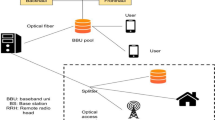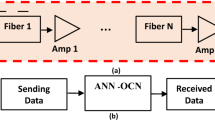Abstract
Due to the Internet’s and communication systems’ rapid technological and service development, communication networks have been impacted by a rise in intricacy. Optical networks, which are vital components of both the core and access networks in communication networks, face major obstacles due to the complexity of the system and the requirement for manual effort. To overcome the current limitations and address the issues with future optical networks, it is essential to install greater intelligence capabilities to enable autonomous as well as flexible network operation. The present study delivers a novel approach for transmission analysis-routing-improved multiagent communication using optical access networks. An optical access network is used here, and routing is handled dynamically using multi-agent communication. A federated convolutional component neural network is then used to analyse the data flow. Throughput, latency from end to end, lifetime of the network, route loss, and energy consumption are all measured experimentally and analysed. When designing the routing protocol, we first model the network as a decentralised multi-agent system and factor in factors like residual energy and connection quality. As a result, the network is better able to adjust to changes and the lifespan of the network may be prolonged. The proposed solution increased network throughput by 97%, decreased end-to-end latency by 54%, prolonged the life of the network by 6%, reduced route loss by 59%, and reduced energy consumption by 55%.




Similar content being viewed by others
Availability of data and materials
All the data’s available in the manuscript.
References
Alyami, S., Bamane, K.D., Charles, R.A.P., Alrizq, M., Alghamdi, A., Dutta, P.: Multichannel power constraints-based SNR estimation for the non-cooperative and cooperative scenarios of multi-user wireless network. Phys. Commun. 58, 102051 (2023)
Barakabitze, A.A., Walshe, R.: SDN and NFV for QoE-driven multimedia services delivery: the road towards 6G and beyond networks. Comput. Netw. 214, 109133 (2022)
Benisha, R.B.: An efficient sheep flock optimization-based hybrid deep RaNN for secure and enhanced video transmission quality. Neural Comput. Appl. 35, 1–16 (2023)
Bernárdez, G., Suárez-Varela, J., López, A., Shi, X., Xiao, S., Cheng, X., Cabellos-Aparicio, A., et al.: MAGNNETO: a graph neural network-based multi-agent system for traffic engineering. IEEE Trans. Cogn Commun. Netw. (2023). https://doi.org/10.1109/TCCN.2023.3235719
Das, S.K., Benkhelifa, F., Sun, Y., Abumarshoud, H., Abbasi, Q.H., Imran, M.A., Mohjazi, L.: Comprehensive review on ML-based RIS-enhanced IoT systems: basics, research progress and future challenges. Comput. Netw. 224, 109581 (2023)
Haghnegahdar, L., Chen, Y., Wang, Y.: Enhancing dynamic energy network management using a multiagent cloud-fog structure. Renew. Sustain. Energy Rev. 162, 112439 (2022)
Jiang, R., Liu, C.: Enhancing marine data transmission with socially aware resilient vessel networks. IEEE Wirel. Commun. 29(3), 72–78 (2022)
Liu, Y., Deng, Y., Nallanathan, A., Yuan, J.: Machine learning for 6G enhanced ultra-reliable and low-latency services. IEEE Wirel. Commun. 30(2), 48–54 (2023)
Nahi, H.A., Al-dolaimy, F., Abbas, F.H., Almohamadi, M., Hasan, M.A., Alkhafaji, M.A., Guneser, M.T.: A multi-objective optimization for enhancing the efficiency of service in flying Ad-Hoc network environment. EAI Endorsed Trans. Scalable Inf. Syst. (2023). https://doi.org/10.4108/eetsis.vi.3442
Osamy, W., Khedr, A.M., Salim, A., Al Ali, A.I., El-Sawy, A.A.: A review on recent studies utilizing artificial intelligence methods for solving routing challenges in wireless sensor networks. PeerJ Comput. Sci. 8, e1089 (2022)
Phull, N., Singh, P., Shabaz, M., Sammy, F.: Performance enhancement of cluster-based Ad Hoc on-demand distance vector routing in vehicular Ad Hoc networks. Sci. Program. (2022). https://doi.org/10.1155/2022/7423989
Prabhu, D., Alageswaran, R., Miruna Joe Amali, S.: Multiple agent based reinforcement learning for energy efficient routing in WSN. Wirel. Netw. 29, 1–11 (2023)
Qanbaryan, M., Derakhshandeh, S.Y., Mobini, Z.: UAV-enhanced damage assessment of distribution systems in disasters with lack of communication coverage. Sustain Energy Grids Netw 33, 100984 (2023)
Raju, C., Rajagopal, S., Venusamy, K., Suriyan, K., Alagarsamy, M.: SDSFLF: fault localization framework for optical communication using software digital switching network. Int. J. Reconfig. Embed. Syst. (IJRES) 12(1), 113–124 (2023)
Seo, S., Han, S., Kim, D.: D-CEWS: DEVS-based cyber-electronic warfare M&S framework for enhanced communication effectiveness analysis in battlefield. Sensors 22(9), 3147 (2022)
Siddiqui, M.U.A., Abumarshoud, H., Bariah, L., Muhaidat, S., Imran, M.A., Mohjazi, L.: URLLC in beyond 5G and 6G networks: an interference management perspective. IEEE Access (2023). https://doi.org/10.1109/ACCESS.2023.3282363
Vanitha, C.N., Malathy, S., Dhanaraj, R.K., Nayyar, A.: Optimized pollard route deviation and route selection using Bayesian machine learning techniques in wireless sensor networks. Comput. Netw. 216, 109228 (2022)
Venu, D., Mayuri, A.V.R., Neelakandan, S., Murthy, G.L.N., Arulkumar, N., Shelke, N.: An efficient low complexity compression based optimal homomorphic encryption for secure fiber optic communication. Optik 252, 168545 (2022)
Wang, B., Wang, X., Li, S.: Resource allocation strategy of power communication network based on enhanced Q-learning. In: 2022 2nd International Conference on Algorithms, High Performance Computing and Artificial Intelligence (AHPCAI), pp. 773–777. IEEE (2022)
Zhu, R., Wu, S., Li, L., Lv, P., Xu, M.: Context-aware multiagent broad reinforcement learning for mixed pedestrian-vehicle adaptive traffic light control. IEEE Internet Things J. 9(20), 19694–19705 (2022)
Funding
No funding.
Author information
Authors and Affiliations
Contributions
JX: conceptualization, methodology, software, data curation, writing—original, draft preparation, visualization, investigation, supervision, software, validation, writing—reviewing and editing.
Corresponding author
Ethics declarations
Conflict of interest
The authors declare that they have no known competing financial interests or personal relationships that could have appeared to influence the work reported in this paper.
Ethical approval
This article does not contain any studies with animals performed by any of the authors.
Additional information
Publisher's Note
Springer Nature remains neutral with regard to jurisdictional claims in published maps and institutional affiliations.
Rights and permissions
Springer Nature or its licensor (e.g. a society or other partner) holds exclusive rights to this article under a publishing agreement with the author(s) or other rightsholder(s); author self-archiving of the accepted manuscript version of this article is solely governed by the terms of such publishing agreement and applicable law.
About this article
Cite this article
Xiao, J. Transmission analysis by using federated machine learning model in optical access networks based multi-agent communication and routing system. Opt Quant Electron 55, 1178 (2023). https://doi.org/10.1007/s11082-023-05475-4
Received:
Accepted:
Published:
DOI: https://doi.org/10.1007/s11082-023-05475-4




